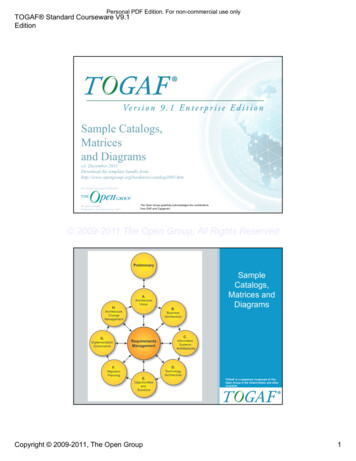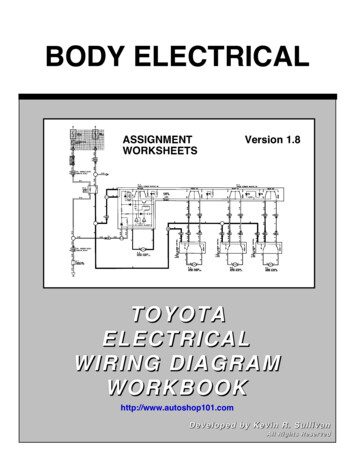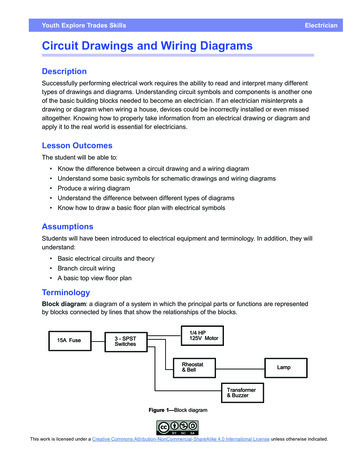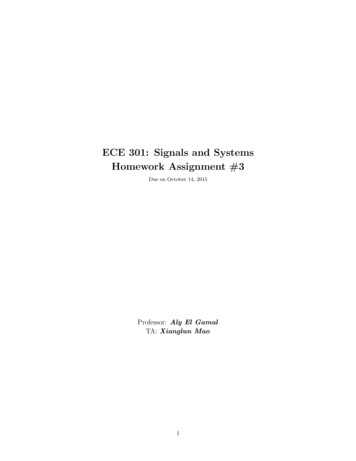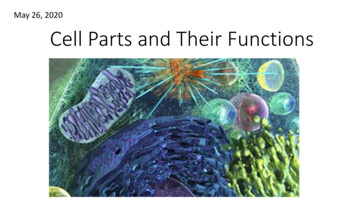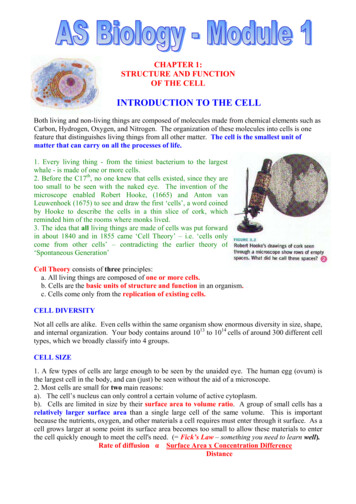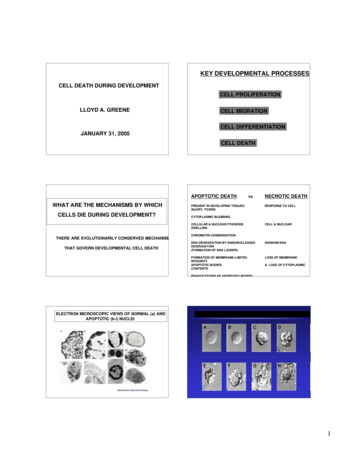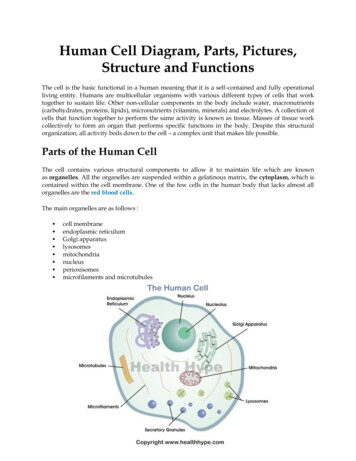
Transcription
Human Cell Diagram, Parts, Pictures,Structure and FunctionsThe cell is the basic functional in a human meaning that it is a self-contained and fully operationalliving entity. Humans are multicellular organisms with various different types of cells that worktogether to sustain life. Other non-cellular components in the body include water, macronutrients(carbohydrates, proteins, lipids), micronutrients (vitamins, minerals) and electrolytes. A collection ofcells that function together to perform the same activity is known as tissue. Masses of tissue workcollectively to form an organ that performs specific functions in the body. Despite this structuralorganization, all activity boils down to the cell – a complex unit that makes life possible.Parts of the Human CellThe cell contains various structural components to allow it to maintain life which are knownas organelles. All the organelles are suspended within a gelatinous matrix, the cytoplasm, which iscontained within the cell membrane. One of the few cells in the human body that lacks almost allorganelles are the red blood cells.The main organelles are as follows : cell membraneendoplasmic reticulumGolgi icrofilaments and microtubules1
Diagram of the human cell illustrating the different parts of the cell.Cell MembraneThe cell membrane is the outer coating of the cell and contains the cytoplasm, substances within itand the organelle. It is a double-layered membrane composed of proteins and lipids. The lipidmolecules on the outer and inner part (lipid bilayer) allow it to selectively transport substances inand out of the cell.Endoplasmic ReticulumThe endoplasmic reticulum (ER) is a membranous structure that contains a network of tubules andvesicles. Its structure is such that substances can move through it and be kept in isolation from therest of the cell until the manufacturing processes conducted within are completed. There are twotypes of endoplasmic reticulum – rough (granular) and smooth (agranular). The rough endoplasmic reticulum (RER / granular ER) contains a combination of proteinsand enzymes. These parts of the endoplasmic reticulum contain a number of ribosomesgiving it a rough appearance. Its function is to synthesize new proteins.The smooth endoplasmic reticulum (SER / agranular ER) does not have any attachedribosomes. Its function is to synthesize different types of lipids (fats). The smooth ER alsoplays a role in carbohydrate and drug metabolism.2
Golgi ApparatusThe Golgi apparatus is a stacked collection of flat vesicles. It is closely associated with theendoplasmic reticulum in that substances produced in the ER are transported as vesicles and fuseswith the Golgi apparatus. In this way, the products from the ER are stored in the Golgi apparatusand converted into different substances that are necessary for the cell’s various functions.LysosomesLysosomes are vesicles that break off from the Golgi apparatus. It varies in size and functiondepending on the type of cell. Lysosomes contain enzymes that help with the digestion of nutrientsin the cell and break down any cellular debris or invading microorganisms like bacteria.A structure that is similar to a lysosome is the secretory vesicle. It contains enzymes that are notused within the cell but emptied outside of the cell, for example the secretory vesicles of thepancreatic acinar cell release digestive enzymes which help with the digestion of nutrients in thegut.PerioxisomesThese organelles are very similar to the lysosomes and contain enzymes that act together in the formof hydrogen peroxide to neutralize substances that may be toxic to the cell. Perioxisomes are formeddirectly from the endoplasmic reticulum rather than from the Golgi apparatus like lysosomes.MitochondriaThese are the powerhouses of the cell and break down nutrients to yield energy. Apart fromproducing its own energy, it also produces a high-energy compound called ATP (adenosinetriphosphate) which can be used as a simple energy source elsewhere. Mitochondria are composedof two membranous layers – an outer membrane that surrounds the structure and an innermembrane that provides the physical sites of energy production. The inner membrane has manyinfoldings that form shelves where enzymes attach and oxidize nutrients. The mitochondria alsocontain DNA which allows it to replicate where and when necessary.NucleusThe nucleus is the master control of the cell. It contains genes, collections of DNA, which determinesevery aspect of human anatomy and physiology. The DNA which is arranged into chromosomesalso contains the blueprint specific for each type of cell which allows for replication of the cell.Within the nucleus is an area known as the nucleolus. It is not enclosed by a membrane but is justan accumulation of RNA and proteins within the nucleus. The nucleolus is the site where theribosomal RNA is transcribed from DNA and assembled.Microfilaments and MicrotubulesMicrofilaments and microtubules are rigid protein substances that form the internal skeleton of thecell known as the cytoskeleton. Some of these microtubules also make up the centrioles and mitotic3
spindles within the cell which are responsible for the division of the cytoplasm when the celldivides. The microtubules are the central component of cilia, small hair-like projections thatprotrude from the surface of certain cells. It is also the central component of specialized cilia like thetail of the sperm cells which beats in a manner to allow the cell to move in a fluid medium.Functions of the Human CellThe functions of the human cell varies based on the type of cell and its location in the human body.All the organelles work together to keep the cell alive and allow it to carry out its specific function.Sometimes these organelles are highly specialized and can vary in size, shape and number.The organelles are the most basic functional units but it cannot exist and operate without the cell as awhole. Its functions include intake of nutrients and other substances, processing of thesecompounds, production of new substances, cell replication and energy production. In specializedcells that need to be motile, like sperm cells, tail-like projections allow for cellular locomotion.The function of each organelle has already been discussed but is worth considering in summary. The cell membrane allows substances to enter and leave the cell. While certain substance likeoxygen can easily diffuse through the cell membrane, others have to actively transportedthrough the process of endocytosis. Small particles are transported by the process ofpinocytosis while larger particles are moved by the process of phagocytosis. These functionscan become highly specialized to allow cells to perform specific activities, like themacrophages that phagocytose invading bacteria to neutralize it.Small and large substances that do not dissolve in the cytoplasm are contained withinvesicles. Lysosomes attach to the vesicles and digest this material.The endoplasmic reticulum and Golgi apparatus synthesize different substances like proteinand fats as required by the cell or designated according to its specific function. It utilizesbasic nutrient molecules that are either dissolved in the cytoplasm or specific substancescontained within vesicles.Some nutrients, specifically carbohydrates, are transported to the mitochondria where it isbroken down further to yield energy. In the process, high-energy molecules known as ATP(adenosine triphosphate) are manufactured and provide energy for other organelles.The genetic material housed in the nucleus provides the blueprint necessary for theproduction of specific compounds by the endoplasmic reticulum and Golgi apparatus. Thegenes also help the cell replicate and codes for the formation of new cells.Secretory vesicles store some of the enzymes and other specialized substances formed by theendoplasmic reticulum and Golgi apparatus. These stored substances are released from thecell when necessary in order to complete various functions that allow the body to function asa whole.4
Sickle Cell Anemia(Sickled Red Blood Cells)The red blood cells possess a protein known as hemoglobin that binds and transports oxygen fromlungs to other body parts. Therefore, hemoglobin is critical for survival and normal bodyfunctioning. Any defect in the gene coding for this oxygen-carrier protein may disrupt all vital bodyfunctions and present a spectrum of life-threatening conditions. Once such condition is sickle cellanemia.Sickle Cell Anemia DefinitionSickle cell anemia (SCA) is an inherited anemic condition that appears due to a defect in the genecoding for hemoglobin (HbS). Owing to the mutation, RBCs become sickle-shaped (crescentshaped). The lifespan of these defective red blood cells are also greatly reduced. Ultimately there is adecline in the red blood cell population leading to anemia. Sickling produces sticky ends that causered blood cells to clump together and clog the blood vessels. Obstructed blood flow and inadequateoxygen supply causes a range of functional disorders that often proves fatal.Sickle Cell Anemia IncidenceSickle cell anemia is more common in the African American population in the United States.However, it is also commonly seen in Indian, east Mediterranean and Middle Eastern communities.About 8% of African Americans are affected with sickle cell disease. It is more common in AfricanAmericans of Central African descent. In Africa, the prevalence may be as high as 30%.Sickle Cell Anemia PathophysiologyRed blood cells, or erythrocytes, typically have a biconcave shape. It is similar to a disc with a centraldepression. Unlike other cells in the body, it does not contain a nucleus. Red blood cells areapproximately 7 to 8 millimeters thick and flexible enough to bend and squeeze through tinycapillaries. Hemoglobin (HbA), a protein that helps in transporting oxygen, fills almost the entirevolume of the RBC cell. Hemoglobin comprises of a simple, iron-containing heme protein molecule.The iron molecules of heme, hold oxygen during its transport through the blood. Oxygen is taken upfrom the lungs and distributed to all tissues in the body for its ongoing metabolism.5
Red Blood Cell Sickle-ShapeA defect in the gene coding for hemoglobin (HbS) changes its molecular structure. Although normaloxygen levels do not precipitate any change in HbS, under low-oxygen level simple molecules ofHbS coalesce together to form complex polymer. Presence of other forms of hemoglobin, dilutes theconcentration of HbS and interferes with its polymerization. Upon being exposed to low-oxygenconditions, biconcave RBC is converted into a sickle shape. Often the initial sickling event isreversible with re-oxygenation causing sickle-shaped RBCs to become biconcave again. However,with recurrent episodes the flexibility is lost. Red blood cells cannot return to the biconcave shapeeven with restoration of normal oxygen levels.Effects of SicklingThe change in shape of red blood cells leads to a host of clinical symptoms. Mutations of hemoglobinalso leads to changes in red blood cell membrane permeability and cellular interactions. Sickle shapeproduces free sticky ends that often glue together forming clumps of cells. Phagocytic immune cellsknown as macrophages tend to destroy these abnormally shaped cells and reduces half-life of redblood cells. This leads to hemolytic anemia, meaning that the hemoglobin concentration of the bloodis lower than normal due to red blood cell destruction . These deformed cells also clog the bloodvessels interrupting normal blood flow. Various organs and tissues of the body are then starved ofoxygen to some degree especially at times of increased demand.6
Consequences of Sickle Cell AnemiaAlthough the effects of sickle cell anemia is widespread, there are more prominent effects on certainorgans and tissues. The low oxygen state adversely affects the bone marrow and bones. The kidneyfunction is also impacted as a result of structural changes of the kidney. The spleen serves as areservoir of red blood cells and other blood cells. Sickle cells anemia therefore also impacts on thefunction of spleen. Portions of the spleen may die as a result of oxygen deprivation. Since the spleenplays an integral role in immune function, the impairment with sickle cell anemia lowers theimmunity. A person may therefore be more prone to various life threatening infections.Sickle Cell Anemia InheritanceSickle cell anemia is an autosomal recessive disease. Inheritance of one copy of the defective genefrom each parent is necessary for the disease to become present. Heterozygous individuals (carriers),having sickle cell trait, possesses only one copy of HbS allele. These individuals produce acombination of normal and mutated hemoglobin. A small population of RBCs may become sickle-7
shaped in carriers but this does not lead to symptoms of the disease. Parents with the sickle cellanemia trait will have: 1 out of 4 children having normal hemoglobin (HbA HbA)1 out of 2 children having sickle cell anemia trait (HbA HbS)1 out of 4 children having sickle cell anemia disease (HbS HbS)Sickle Cell Anemia CausesAny event that increases the acidic concentration in the blood is more likely to induce sickling of thered blood cells. The main events that may precipitate such changes include: Low oxygen level in the blood (hypoxia)Dehydration or loss of body fluids (concentrates acids in the blood)InfectionsOther less common triggers include: Cold exposureAcidosisEmotional and physical stressAlcohol consumptionFolic acid deficiencyIngestion of certain toxinsSickle Cell Anemia and MalariaThe sickle cell trait offers resistance to deadly malarial infection caused by parasite, Plasmodiumfalciparum. Possible reasons include: Sickling removes parasites from the cellSickled cells possibly makes penetration and metabolic prospects difficult for the parasitesHowever, this protection from malaria should not detract from the fact that sickle cell anemia itselfcan have fatal consequences.Sickle Cell Anemia SymptomsReduction in blood flow to various tissues and organs as a result of obstruction of the block vesselscoupled with lower oxygen concentration leads to damage of tissue that is often perceived as pain. Italso compromises the function of the affected tissue or organ thereby contributing to various othersymptoms.8
PainPain is the most notable symptom of sickle cell anemia. The severity of pain depends on the extent ofvessel obstruction or organ damage. Typical sickle cell disease pain appears spontaneously and maylast for few hours to several days. Extremely painful conditions may need immediate medicalattention. Commonly affected areas include the abdomen and the long bones of the extremities.Other symptomsInitial symptoms appear 6 months after birth. Lack of tissue’s blood supply and oxygen leads to cell death (necrosis) that may presentsymptoms including:Painful, swollen hands and feet (dactylitis)Cell death in joints (joint necrosis) and bones (avascular necrosis)Bone pain due to bone marrow infarctionSickle Cell Anemia ComplicationsSevere cases of sickle cell anemia may lead to various complications such as : Respiratory distressParvovirus infectionIncreased susceptibility towards lethal bacterial infectionsPulmonary hypertension – high pressure in lungs causing difficult breathingOrgan damageFormation of bile stones and obstruction of bile duct.Renal failureLoss of visionRetarded body growth and delayed pubertyHeart failureStroke and other neurological conditionsSickle Cell Anemia DiagnosisAlthough the symptoms and family history may raise the suspicion of sickle cell anemia, furtherinvestigations are required. Various tests may be conducted to detect the following : Presence of HbS gene which can also be performed on the unborn child throughamniocentesisSickling of most of the red blood cells in a blood sampleReduction in the number of red blood cellsBone deformities9
Picture from Wikimedia CommonsSickle Cell Anemia TreatmentPreventative care is advisable for managing the symptoms of sickle cell anemia. This includes : Refraining from mental and physical exertionSufficient water intakeFolic acid supplements and healthy dietSupplementary oxygen supply and pain-relieving medications should be used foremergencies.TransfusionsBlood transfusions are not routinely required for sickle cell anemia. Anemia can be prevented It isonly considered when there is a sudden destruction of large amounts of red blood cells associatedwith certain infections or acute splenic sequestration.Bone marrow transplantationBone marrow transplant offers the most effective strategy for treating sickle cell anemia. The bonemarrow cells of the sickle cell anemia patient is replaced by marrow from a healthy donor. Owing tothe risk of rejection by the patient’s body and the scarcity of donors, treatment of secondarysymptoms serves as a better option.10
Medication Antibiotics and vaccinations to treat or prevent fatal infectionsDeferasirox prevents excessive build up of iron that causes organ damageHydroxyurea reduces the frequency of painful episodes and stimulates production of fetalhemoglobin that prevents sickling of red blood cells. However, long term use may increasethe risk of infections and lead to leukemia.Other medications may be used to treat and manage the various complications associated with sicklecell anemia.11
2 Diagram of the human cell illustrating the different parts of the cell. Cell Membrane The cell membrane is the outer coating of the cell and contains the cytoplasm, substances within it and the organelle. It is a double-layered membrane composed of proteins and lipids.
